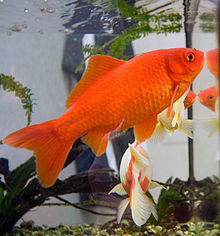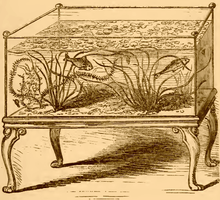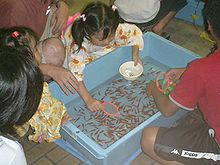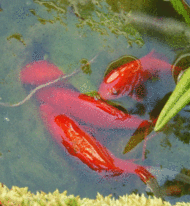Goldfish
From Wikipedia, the free encyclopedia
| Goldfish | |
|---|---|
 | |
| Conservation status | |
| Domesticated | |
| Scientific classification | |
| Kingdom: | Animalia |
| Phylum: | Chordata |
| Class: | Actinopterygii |
| Order: | Cypriniformes |
| Family: | Cyprinidae |
| Genus: | Carassius |
| Species: | C. auratus[1] |
| Subspecies: | C. a. auratus |
| Trinomial name | |
| Carassius auratus auratus (Linnaeus, 1758) | |
The goldfish (Carassius auratus auratus) is a freshwater fish in the family Cyprinidae of order Cypriniformes. It was one of the earliest fish to be domesticated, and is one of the most commonly kept aquarium fish. A relatively small member of the carp family (which also includes the koi carp and the crucian carp), the goldfish is a domesticated version of a dark-gray/olive/brown carp (Carassius auratus) native to east Asia (first domesticated in China) that was introduced to Europe in the late 17th century. The mutation that gave rise to the goldfish is also known from other cyprinid species, such as common carp and tench.
Goldfish may grow to a maximum length of 23 inches (58 cm) and a maximum weight of 9.9 pounds (4 kg) although this is rare; most individual goldfish grow to under half this size. In optimal conditions, goldfish may live more than 40 years;[2] however, most household goldfish generally live six to eight years.
Contents |
History

In ancient China, various species of carp (collectively known as Asian carps) were domesticated and have been reared as food fish for thousands of years. Some of these normally gray or silver species have a tendency to produce red, orange or yellow color mutations; this was first recorded in the Jin Dynasty (265–420)
During the Tang Dynasty (618–907), it was popular to raise carp in ornamental ponds and watergardens. A natural genetic mutation produced gold (actually yellowish orange) rather than silver coloration. People began to breed the gold variety instead of the silver variety, keeping them in ponds or other bodies of water. On special occasions at which guests were expected they would be moved to a much smaller container for display.
In 1162, the Empress of the Song Dynasty ordered the construction of a pond to collect the red and gold variety. By this time, people outside the imperial family were forbidden to keep goldfish of the gold (yellow) variety, yellow being the imperial color. This is probably the reason why there are more orange goldfish than yellow goldfish, even though the latter are genetically easier to breed

The occurrence of other colors (apart from red and gold) was first recorded in 1276. The first occurrence of fancy tailed goldfish was recorded in the Ming dynasty. In 1502, goldfish were introduced to Japan, where the Ryukin and Tosakin varieties were developed. In 1611, goldfish were introduced to Portugal and from there to other parts of Europe.
During the 1620s, goldfish were highly regarded in Southern Europe because of their metallic scales, and symbolized good luck and fortune. It became tradition for married men to give their wives a goldfish on their one year anniversary, as a symbol for the prosperous years to come. This tradition quickly died, as goldfish became more available, losing their status. Goldfish were first introduced to North America around 1850 and quickly became popular in the United States.
Wild form
The wild form is the Prussian carp (Carassius gibelio). Some sources instead claim the Crucian carp (Carassius carassius) as the wild version. While closely related, they can be differentiated by the following characteristics:
- C. auratus have a more pointed snout while the snout of a C. carassius is well rounded.
- C. gibelio often has a grey/greenish color, while crucian carps are always golden bronze.
- Juvenile crucian carp have a black spot on the base of the tail which disappears with age. In C. auratus this tail spot is never present.
- C. auratus have fewer than 31 scales along the lateral line while crucian carp have 33 scales or more.
When found in nature, goldfish are an olive green color, and return to this color if domesticated and then released.[citation needed]
[edit] Varieties of domesticated goldfish
Selective breeding over centuries has produced several color variations, some of them far removed from the "golden" color of the originally domesticated fish. There are also different body shapes, fin and eye configurations. Some extreme versions of the goldfish live only in aquariums—they are much less hardy than varieties closer to the "wild" original. However, some variations are hardier, such as the Shubunkin. The main varieties are:
| Common goldfish | Black Moor | Bubble Eye | |||
|---|---|---|---|---|---|
| Common goldfish differ only in color from their ancestor, the Prussian carp. Common goldfish come in a variety of colors including red, orange/gold, white, black and yellow or 'lemon' goldfish. | The Black moor is a telescope-eyed variety of fancy goldfish that has a characteristic pair of protruding eyes. It is also referred to as popeye, telescope, kuro demekin in Japan and dragon-eye in China. |  | The small, fancy Bubble Eye has upward pointing eyes accompanied by two large fluid-filled sacs. |  | |
| Celestial Eye | Comet (goldfish) | Fantail (goldfish) | |||
| Fancy Celestial eye goldfish or Choten gan has a double tail and a breed-defining pair of upturned, telescope eyes with pupils gazing skyward. | The comet or comet-tailed goldfish is the most common fancy variety in the United States. It is similar to the common goldfish, except slightly smaller and slimmer, and is mainly distinguished by its long, deeply forked tail. |  | The Fantail goldfish is the western form of the Ryukin and possesses an egg-shaped body, a high dorsal fin, a long quadruple caudal fin, and no shoulder hump. |  | |
| Lionhead (goldfish) | Oranda | Pearlscale | |||
| The fancy lionhead has a hood. This fish is the precursor to the ranchu. |  | The fancy oranda is characterized by a prominent raspberry-like hood or (also known as wen or headgrowth) that encases the whole head except for the eyes and mouth. |  | The fancy pearlscale or chinshurin in Japanese, is spherical-bodied with finnage similar to the fantail. |  |
| Pompom (goldfish) | Ryukin | Shubunkin | |||
| The fancy Pompoms or pompon or hana fusa have bundles of loose fleshy outgrowths between the nostrils, on each side of the head. | The fancy ryukin has a short, deep body with a characteristic shoulder hump. |  | Fancy and hardy Japanese Shubunkins (朱文金) (translated literally as "red brocade") have single tail with nacreous scales, and a pattern known as calico. |  | |
| Telescope eye | Ranchu | Panda Moor | |||
| The fancy telescope eye or demekin is characterized by its protruding eyes. It is also known as globe eye or dragon eye goldfish. |  | The fancy Japanese ranchu is hooded. Japanese refer to it as the "king of goldfish". |  | The fancy panda moor has a characteristic black-and-white color pattern and protruding eyes. |  |
| Veiltail | |||||
| The fancy veiltail is known for its extra-long, flowing double tail. |  | ||||
Chinese Goldfish classification
Chinese tradition classifies goldfish into 4 main types. These classifications are not commonly used in the West.
- Ce (may also be called "grass")—Goldfish without fancy anatomical features. These include the common goldfish, comet goldfish and Shubunkin.
- Wen—Goldfish have a fancy tail, e.g., Fantails and Veiltails ("Wen" is also the name of the characteristic headgrowth on such strains as Oranda and Lionhead)
- Dragon Eye—Goldfish have extended eyes, e.g. Black Moor, Bubble Eye, and Telescope Eye
- Egg—Goldfish have no a dorsal fin, and usually have an 'egg-shaped' body, e.g. Lionhead (note that a Bubble Eye without a dorsal fin belongs to this group)
In ponds
Goldfish are popular pond fish, since they are small, inexpensive, colorful, and very hardy. In an outdoor pond or water garden, they may even survive for brief periods if ice forms on the surface, as long as there is enough oxygen remaining in the water and the pond does not freeze solid. Common goldfish, London and Bristol shubunkins, jikin, wakin, comet and some hardier fantail goldfish can be kept in a pond all year round in temperate and subtropical climates. Moor, veiltail, oranda and lionhead can be kept safely in outdoor ponds only in the summer, and in more tropical climates.
Small to large ponds are fine though the depth should be at least 80 centimeters (31.5 in) to avoid freezing. During winter, goldfish become sluggish, stop eating, and often stay on the bottom of the pond. This is completely normal; they become active again in the spring. A filter is important to clear waste and keep the pond clean. Plants are essential as they act as part of the filtration system, as well as a food source for the fish. Plants are further beneficial since they raise oxygen levels in the water.
Compatible fish include rudd, tench, orfe and koi, but the latter require specialized care. Ramshorn snails are helpful by eating any algae that grows in the pond. Without some form of animal population control, goldfish ponds can easily become overstocked. Fish such as orfe consume goldfish eggs.
Koi may also interbreed with the goldfish to produce a sterile hybrid fish.
In aquaria

Like most carp, goldfish produce a large amount of waste both in their faeces and through their gills, releasing harmful chemicals into the water. Build-up of this waste to toxic levels can occur in a relatively short period of time, and can easily cause a goldfish's death. For common and comet varieties, each goldfish should have about 20 US gallons (76 l; 17 imp gal) of water. Fancy goldfish (which are smaller) should have about 10 US gallons (38 l; 8.3 imp gal) per goldfish. The water surface area determines how much oxygen diffuses and dissolves into the water. A general rule is have 1 square foot (0.093 m2). Active aeration by way of a water pump, filter or fountain reduces the minimum surface area.
The goldfish is classified as a coldwater fish, and can live in unheated aquaria at a temperature comfortable for humans. However, rapid changes in temperature (for example in an office building in winter when the heat is turned off at night) can kill them, especially if the tank is small. Care must also be taken when adding water, as the new water may be of a different temperature. Temperatures under about 10 °C (50 °F) are dangerous to fancy varieties, though commons and comets can survive slightly lower temperatures. Extremely high temperatures (over 30 °C (86 °F) can also harm goldfish. However, higher temperatures may help fight protozoan infestations by accelerating the parasite's life-cycle—thus eliminating it more quickly. The optimum temperature for goldfish is around 25 °C (77 °F).
Like all fish, goldfish do not like to be petted. In fact, touching a goldfish can endanger its health, because it can cause the protective slime coat to be damaged or removed, exposing the fish’s skin to infection from bacteria or water-born parasites. However, goldfish respond to people by surfacing at feeding time, and can be trained or acclimated to taking pellets or flakes from human fingers. The reputation of goldfish dying quickly is often due to poor care. The lifespan of goldfish in captivity can extend beyond 10 years.
If left in the dark for a period of time, goldfish gradually change color until they are almost gray.[citation needed] Goldfish produce pigment in response to light, in a similar manner to how human skin becomes tanned in the sun. Fish have cells called chromatophores that produce pigments which reflect light, and give the fish coloration. The color of a goldfish is determined by which pigments are in the cells, how many pigment molecules there are, and whether the pigment is grouped inside the cell or is spaced throughout the cytoplasm.
Feeding
In the wild, diet consists of crustaceans, insects, and various plant matter.They are omnivorous and do best with a wide variety of fresh vegetables and fruit to supplement a staple flake or pellet diet.[citation needed]
Like most fish, goldfish are opportunistic feeders and do not stop eating on their own accord. When excess food is available, they produce more waste and faeces, partly due to incomplete protein digestion. Overfeeding can sometimes be diagnosed by observing faeces trailing from the fish's cloaca.
Feed goldfish only as much food as they consume in three to four minutes, no more than twice a day. Overfeeding does not increase the fish's size but can be fatal, typically by blocking or bursting the intestines. This happens most often with selectively bred goldfish, which have a convoluted intestinal tract. Fish keepers with new ryukin, fantail, oranda, lionhead or other fancy goldfish must carefully determine how much they need.
Goldfish-specific food has less protein and more carbohydrate than conventional fish food. It is sold in two consistencies—flakes that float, and pellets that sink. Enthusiasts may supplement this diet with shelled peas (with outer skins removed), blanched green leafy vegetables, and bloodworms. Young goldfish benefit from the addition of brine shrimp to their diet. As with all animals, goldfish preferences vary.
Wild goldfish and relationship to Prussian carp
Fancy goldfish are unlikely to survive in the wild because of their bright fin colors; however the hardier varieties such as the Shubunkin may survive long enough to breed with wild cousins. Common and comet goldfish can survive, and even thrive, in any climate that can support a pond.
Introduction of wild goldfish can cause problems for native species. Within three breeding generations the vast majority of the goldfish spawn revert to their natural olive color. Goldfish can hybridize with certain other species of carp.
There are subtle differences which demonstrate that while the Prussian carp is the ancestor of the goldfish, they have sufficiently diverged to be considered separate species.[11]
Behavior
Behavior can vary widely both because goldfish live in a variety of environments, and because their behavior can be conditioned by their owners.
Goldfish have strong associative learning abilities, as well as social learning skills. In addition, their visual acuity allows them to distinguish between individual humans. Owners may notice that fish react favorably to them (swimming to the front of the glass, swimming rapidly around the tank, and going to the surface mouthing for food) while hiding when other people approach the tank. Over time, goldfish learn to associate their owners and other humans with food, often "begging" for food whenever their owners approach.[citation needed]
Responses from a blind goldfish proved that it recognized one particular family member and a friend by voice, or vibration of sound.[citation needed] This behavior was remarkable because it showed that the fish recognized the vocal vibration or sound of two people specifically out of seven in the house.
Goldfish are gregarious, displaying schooling behavior, as well as displaying the same types of feeding behaviors. Goldfish may display similar behaviors when responding to their reflections in a mirror.[citation needed]
Goldfish that have constant visual contact with humans also stop considering them to be a threat. After being kept in a tank for several weeks, sometimes months, it becomes possible to feed a goldfish by hand without it shying away.
Goldfish have learned behaviors, both as groups and as individuals, that stem from native carp behavior. They are a generalist species with varied feeding, breeding, and predator avoidance behaviors that contribute to their success. As fish they can be described as "friendly" towards each other. Very rarely does a goldfish harm another goldfish, nor do the males harm the females during breeding. The only real threat that goldfish present to each other is competing for food. Commons, comets, and other faster varieties can easily eat all the food during a feeding before fancy varieties can reach it. This can lead to stunted growth or possible starvation of fancier varieties when they are kept in a pond with their single-tailed brethren. As a result, care should be taken to combine only breeds with similar body type and swim characteristics.
Intelligence
Goldfish can be trained to recognize and to react to light signals of different colors by using positive reinforcement. Goldfish have a memory-span of at least three months and can distinguish between different shapes, colours and sounds. Another experiment demonstrated retention of more than 1 month. Fish respond to certain colors most evidently in relation to feeding. Fish learn to anticipate feedings provided they occur at around the same time everyday. Goldfish can learn tricks, such as the limbo, slalom, fetch and soccer, using positive reinforcement training techniques.
Range and habitat
Goldfish inhabit ponds, and other slow or still moving bodies of water in depths up to 20 meters (66 ft). Their native climate is subtropical to tropical and they live in freshwater with a pH of 6.0–8.0, a water hardness of 5.0–19.0 dGH.[citation needed]
They can survive in temperatures ranging from 40–106 °F (4–41 °C) although only briefly at the higher temperatures. They are ill-suited to live in a heated tropical fish tank, preferring the greater concentration of oxygen in unheated tanks; some believe that the heat burns them. However, goldfish can live in outdoor ponds in which the temperature often spikes above 86 °F (30 °C).[citation needed]
Sudden changes in water temperature can be fatal to any fish, including the goldfish. When transferring a store-bought goldfish to a pond or tank, the temperature in the transport container should be equalized by placing it in the destination container for at least 20 minutes before releasing the goldfish. If the temperature change is large, such as from room temperature at 21 °C (70 °F) to a cool garden pond at 4 °C (39 °F) the transition must be stretched over days or weeks.[citation needed]
Because goldfish eat live plants, their presence in a planted aquarium can be problematic. Only a few aquarium plant species for example Cryptocoryne and Anubias, can survive around goldfish, but they require special attention so that they are not uprooted. Plastic plants are often more durable, but the branches can irritate or harm a fish that touches one.[citation needed]
Reproduction
Goldfish may only grow to sexual maturity with enough water and the right nutrition. Most goldfish breed in captivity, particularly in pond settings. If kept well, they may breed indoors, but not in a small fishbowl. Breeding usually happens after a significant temperature change, often in spring. Males chase females, prompting them to release their eggs by bumping and nudging them.
Goldfish, like all cyprinids, are egg-layers. Their eggs are adhesive and attach to aquatic vegetation, typically dense plants such as Cabomba or Elodea or a spawning mop. In captivity, eggs must be moved into another tank, because adults eat young that they encounter. The eggs hatch within 48 to 72 hours.
Hatchlings (fry) are large enough to be described as appearing like "an eyelash with two eyeballs". Within a week or so, the fry begins to assume its final shape, although a year may pass before they develop a mature goldfish color; until then they are a metallic brown like their wild ancestors. In their first weeks of life, the fry grow quickly—an adaptation born of the high risk of getting devoured by the adult goldfish (or other fish and insects) in their environment.
Some highly bred goldfish can no longer breed naturally due to their altered shape. The artificial breeding method called "hand stripping" can assist nature, but can harm the fish if not done correctly.
Mosquito control
Like some other popular aquarium fish, such as the guppy, goldfish and other carp are frequently added to stagnant bodies of water to reduce mosquito populations. They are used to prevent the spread of West Nile Virus, which relies on mosquitoes to migrate. However, introducing goldfish has often had negative consequences for local ecosystems.
Controversy over proper treatment

Some countries ban the sale of traditional fishbowls under "animal rights" legislation due to the risk of stunting, deoxygenation and ammonia/nitrite poisoning in such a small environment. Because of their large oxygen needs and high waste output, such bowls are no longer considered appropriate housing for goldfish.
In many countries, carnival and fair operators commonly give goldfish away in plastic bags as prizes. In late 2005 Rome, Italy banned the use of goldfish and other animals as carnival prizes. Rome has also banned the use of "goldfish bowls", on animal cruelty grounds. In the United Kingdom, the government proposed banning this practice as part of its Animal Welfare Bill, though this has since been amended to only prevent goldfish being given as prizes to unaccompanied minors.
In Japan, during summer festivals and religious holidays (ennichi), a traditional game called goldfish scooping is played, in which a player scoops goldfish from a basin with a special scooper. Sometimes bouncy balls are substituted for goldfish.
Although edible, goldfish are rarely eaten. A fad among American college students for many years was swallowing goldfish as a stunt and as a fraternity initiation process. The first recorded instance was in 1939 at Harvard University. The practice gradually fell out of popularity over the course of several decades and is rarely practiced today.
See also
- Aquarium - different types of aquariums
- Carp
- Cyprinid - other members of carp family
- List of freshwater aquarium plant species for plant species compatible with a goldfish








0 التعليقات:
Post a Comment